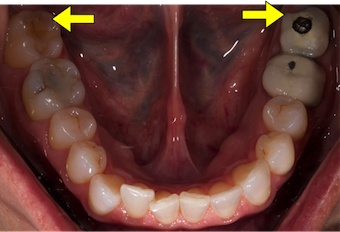Occlusion & Wear
Why 'Watching' Might Be Negligent
By Steve Ratcliff on January 24, 2014 | 8 comments The image on the left is of a 28-year-old patient I saw for a routine exam. She was unaware that she had any wear on her teeth and also didn't realize that she might be engaging in some parafunctional activity.
The image on the left is of a 28-year-old patient I saw for a routine exam. She was unaware that she had any wear on her teeth and also didn't realize that she might be engaging in some parafunctional activity.She has wear facets on her molars that are suggestive of what we call "CR" bruxing or bruxing from a retruded position. The patient pulls the jaw posteriorly until the back teeth contact and then squeezes into a more forward position. Frequently, the earliest signs are wear facets on the distal marginal ridges or inclines of lower second molars.
Intervention at this point might be an occlusal guard and perhaps an equilibration.
 Interestingly, the image on the right is her mother, essentially showing what can happen over a 28-year period without any intervention. The mother has always done what her dentists suggested and even though she knows she grinds her teeth no one has ever suggested that there might be a way to minimize the damage now and in the future.
Interestingly, the image on the right is her mother, essentially showing what can happen over a 28-year period without any intervention. The mother has always done what her dentists suggested and even though she knows she grinds her teeth no one has ever suggested that there might be a way to minimize the damage now and in the future.The result was loss of #18 secondary to a root fracture; wear into the dentin and a crack into the fossa of #31 and fractured porcelain on the crown on #19.
It is entirely possible that much of this dentistry could have been avoided with early intervention if her dentists had recognized the consequences of no treatment and simply had the discussion with her.
I understand that there are many patients who might not want to do anything; however, if they understand the risks of no treatment and the long-term benefits of treatment, they WILL say yes.

Comments
January 25th, 2014
January 25th, 2014
January 25th, 2014
January 25th, 2014
January 28th, 2014
January 1st, 2015
January 2nd, 2015
March 24th, 2015
June 9th, 2015